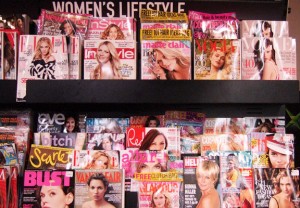October 18, 2013, by melissayoong
Reading Between the Headlines and Getting the Plot (Part 2)
In my previous blog post, I had emphasised that being effective readers requires more than merely understanding words – the ability to identify the writer’s implicit beliefs and bias is also very important.

I once read an article in the “women’s section” of a local newspaper where the writer stated as fact that women “always have a problem with … their bodies”. More critical readers would question the truth of this statement, thus uncovering the writer’s sexist beliefs that females are vain and insecure about their looks.
This writer then went on to justify the newspaper’s regular publishing of articles relating to the physical aspects of women – namely to help women “to always have a positive body image, even if we don’t have a perfect body to begin with”. We can see that the adjective “perfect” is vague and is, in fact, based on idealised female beauty as defined by the popular media. Ironically, one of the leading causes of body image issues among females is the unrealistic standards of beauty set by the media. For example, skin or hair that does not meet these standards is commonly labelled with the noun “woe” or “problem”.
One such “beauty woe” that I’ve read is having “virtually no eyebrows, too much eyebrows [or] … where it’s over plucked”. In this type of articles, the reader is invited to share the writer’s unwritten belief that it is important for women to have the “perfect” eyebrows which are “done properly”, while to have “virtually no eyebrows, too much eyebrows” or “over plucked” eyebrows is unacceptable. However, as mentioned previously, the adjective “perfect” is vague and dictated by cosmetics companies, as is the verb phrase “done properly”.
In order to make their advice more persuasive, women’s magazines often invoke a friendly, sisterly voice, such as by using the informal second-person pronoun “you” or the inclusive “we” as well as words from the semantic field of assistance (e.g. “find”, “help” and “tips”) in order to convey solidarity with the reader and the friendly desire to help. Nevertheless, what these articles are really saying is that women must meet the idealised expectations of feminine beauty as established by the beauty industry and the media.
The female personalities and celebrities featured in women’s media are regularly labelled as “hot”, “gorgeous”, “curvy” or “sexy”. Even though these women are assessed positively for their beauty, such adjectives place strong focus on the women’s sexuality rather than their character or career achievements, evaluating them from a male perspective of sexual attractiveness and thereby constituting them as sexual objects. In one article, a female television presenter was referred to as “the beauty with brains”. While this may seem complimentary on the surface, “beauty” occupied the central position as head noun while “brains” was placed in the prepositional phrase. In other words, the woman had been defined primarily by her looks and not her intelligence.
From these examples, we can see that being proficient readers entails more than merely understanding the words on the page. We need to be read critically in order to identify the ideology that is implicitly conveyed and contest conventionalised ways of thinking.
Image: downloaded from http://womensenews.org/story/media-stories/130622/brainwash-magazine-scorns-airbrushed-images (18 Oct 2013), labelled as Credit: jaimelondonboy on Flickr, Under Creative Commons (CC BY-NC-ND 2.0)
-
Post a comment
